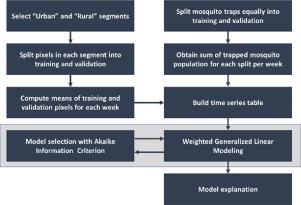Acta Tropica ( IF 2.1 ) Pub Date : 2020-12-29 , DOI: 10.1016/j.actatropica.2020.105809 Oladimeji Mudele , Alejandro C. Frery , Lucas F.R. Zanandrez , Alvaro E. Eiras , Paolo Gamba

|
Mosquitoes propagate many human diseases, some widespread and with no vaccines. The Ae. aegypti mosquito vector transmits Zika, Chikungunya, and Dengue viruses. Effective public health interventions to control the spread of these diseases and protect the population require models that explain the core environmental drivers of the vector population. Field campaigns are expensive, and data from meteorological sites that feed models with the required environmental data often lack detail. As a consequence, we explore temporal modeling of the population of Ae. aegypti mosquito vector species and environmental conditions– temperature, moisture, precipitation, and vegetation– have been shown to have significant effects. We use earth observation (EO) data as our source for estimating these biotic and abiotic environmental variables based on proxy features, namely: Normalized difference vegetation index, Normalized difference water index, Precipitation, and Land surface temperature. We obtained our response variable from field-collected mosquito population measured weekly using 791 mosquito traps in Vila Velha city, Brazil, for 36 weeks in 2017, and 40 weeks in 2018. Recent similar studies have used machine learning (ML) techniques for this task. However, these techniques are neither intuitive nor explainable from an operational point of view. As a result, we use a Generalized Linear Model (GLM) to model this relationship due to its fitness for count response variable modeling, its interpretability, and the ability to visualize the confidence intervals for all inferences. Also, to improve our model, we use the Akaike Information Criterion to select the most informative environmental features. Finally, we show how to improve the quality of the model by weighting our GLM. Our resulting weighted GLM compares well in quality with ML techniques: Random Forest and Support Vector Machines. These results provide an advancement with regards to qualitative and explainable epidemiological risk modeling in urban environments.
中文翻译:

利用地球观测数据和广义线性模型对登革热媒介种群进行建模
蚊子传播许多人类疾病,其中一些疾病广泛传播且没有疫苗。该阂。埃及蚊媒传播寨卡病毒,基孔肯雅热和登革热病毒。有效的公共卫生干预措施需要控制这些媒介的核心环境驱动因素,才能控制这些疾病的传播并保护其种群。野战活动的成本很高,而且从气象站获取的具有所需环境数据的模型的数据通常缺乏细节。因此,我们探索了Ae种群的时间模型。埃及蚊媒种类和环境条件(温度,湿度,降水和植被)已显示出显着影响。我们使用地球观测(EO)数据作为基于代理特征估算这些生物和非生物环境变量的来源,这些特征包括:归一化植被指数,归一化差异水指数,降水量和地表温度。我们从2017年在巴西维拉维尔哈市使用791个诱蚊器每周测量一次的野外采集的蚊虫种群中获得的响应变量,分别在2017年和2018年分别为36周和40周。 。但是,从操作的角度来看,这些技术既不直观也不可解释。结果是,我们使用通用线性模型(GLM)对这种关系进行建模,因为它适合计数响应变量建模,其可解释性以及可视化所有推断的置信区间的能力。另外,为了改进我们的模型,我们使用“赤池信息准则”来选择最有用的环境特征。最后,我们展示了如何通过加权GLM来提高模型的质量。我们得出的加权GLM与ML技术(随机森林和支持向量机)在质量上具有很好的比较。这些结果在定性和可解释的城市环境中流行病学风险建模方面取得了进展。我们使用“赤池信息准则”来选择最有用的环境特征。最后,我们展示了如何通过加权GLM来提高模型的质量。我们得出的加权GLM与ML技术(随机森林和支持向量机)在质量上具有很好的比较。这些结果在定性和可解释的城市环境中流行病学风险建模方面取得了进展。我们使用“赤池信息准则”来选择最有用的环境特征。最后,我们展示了如何通过加权GLM来提高模型的质量。我们得出的加权GLM与ML技术(随机森林和支持向量机)在质量上具有很好的比较。这些结果在定性和可解释的城市环境中流行病学风险建模方面取得了进展。









































 京公网安备 11010802027423号
京公网安备 11010802027423号